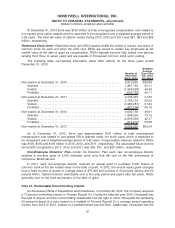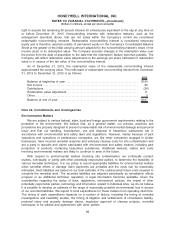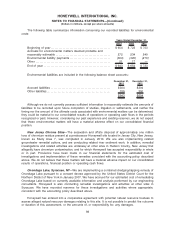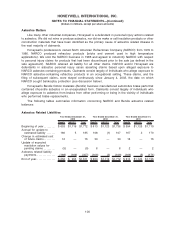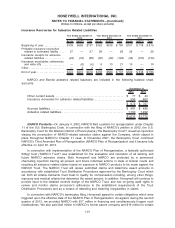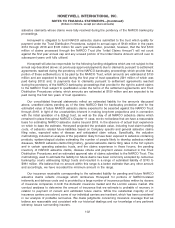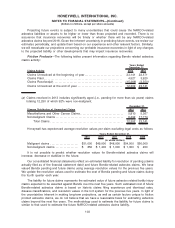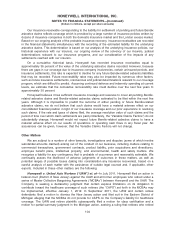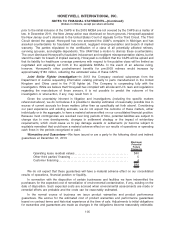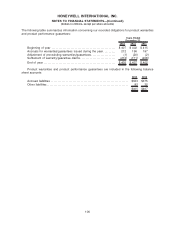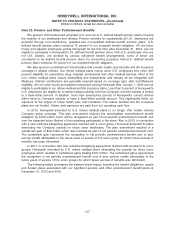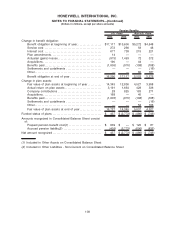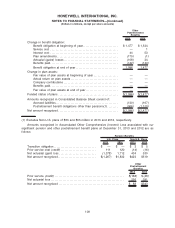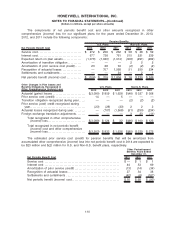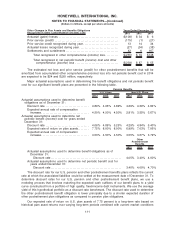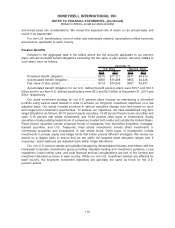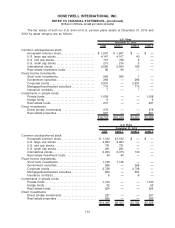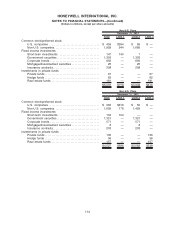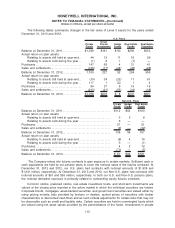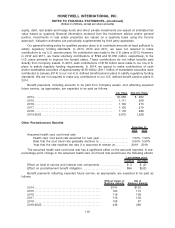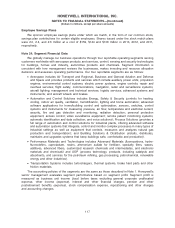Honeywell 2013 Annual Report Download - page 119
Download and view the complete annual report
Please find page 119 of the 2013 Honeywell annual report below. You can navigate through the pages in the report by either clicking on the pages listed below, or by using the keyword search tool below to find specific information within the annual report.Note 23. Pension and Other Postretirement Benefits
We sponsor both funded and unfunded U.S. and non-U.S. defined benefit pension plans covering
the majority of our employees and retirees. Pension benefits for substantially all U.S. employees are
provided through non-contributory, qualified and non-qualified defined benefit pension plans. U.S.
defined benefit pension plans comprise 75 percent of our projected benefit obligation. All non-union
hourly and salaried employees joining Honeywell for the first time after December 31, 2012, are not
eligible to participate in Honeywell’s U.S. defined benefit pension plans. Non-U.S. employees, who are
not U.S. citizens, are covered by various retirement benefit arrangements, some of which are
considered to be defined benefit pension plans for accounting purposes. Non-U.S. defined benefit
pension plans comprise 25 percent of our projected benefit obligation.
We also sponsor postretirement benefit plans that provide health care benefits and life insurance
coverage to eligible retirees. Our retiree medical plans mainly cover U.S. employees who retire with
pension eligibility for prescription drug, hospital, professional and other medical services. Most of the
U.S. retiree medical plans require deductibles and copayments, and virtually all are integrated with
Medicare. Retiree contributions are generally required based on coverage type, plan and Medicare
eligibility. All non-union hourly and salaried employees joining Honeywell after January 1, 2000 are not
eligible to participate in our retiree medical and life insurance plans. Less than 5 percent of Honeywell’s
U.S. employees are eligible for a retiree medical subsidy from the Company; and this subsidy is limited
to a fixed-dollar amount. In addition, more than seventy-five percent of Honeywell’s current retirees
either have no Company subsidy or have a fixed-dollar subsidy amount. This significantly limits our
exposure to the impact of future health care cost increases. The retiree medical and life insurance
plans are not funded. Claims and expenses are paid from our operating cash flow.
In 2013, Honeywell amended its U.S. retiree medical plans to no longer offer certain retirees
Company group coverage. This plan amendment reduced the accumulated postretirement benefit
obligation by $166 million which will be recognized as part of net periodic postretirement benefit cost
over the expected future lifetime of the remaining participants in the plans. Also in 2013, in connection
with a new collective bargaining agreement reached with a union group, Honeywell amended its plans
eliminating the Company subsidy for these union employees. The plan amendment resulted in a
curtailment gain of $42 million which was included as part of net periodic postretirement benefit cost.
The curtailment gain represents the recognition in net periodic postretirement benefit cost of prior
service credits attributable to the future years of service of the union group for which future accrual of
benefits has been eliminated.
In 2011, in connection with new collective bargaining agreements reached with several of its union
groups, Honeywell amended its U.S. retiree medical plans eliminating the subsidy for those union
employees which resulted in curtailment gains totaling $167 million. The curtailment gains represented
the recognition in net periodic postretirement benefit cost of prior service credits attributable to the
future years of service of the union groups for which future accrual of benefits was eliminated.
The following tables summarize the balance sheet impact, including the benefit obligations, assets
and funded status associated with our significant pension and other postretirement benefit plans at
December 31, 2013 and 2012.
107
HONEYWELL INTERNATIONAL INC.
NOTES TO FINANCIAL STATEMENTS—(Continued)
(Dollars in millions, except per share amounts)


